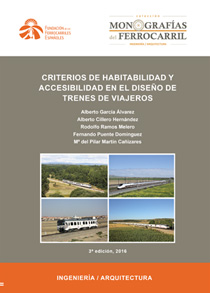
Categories
Publications
Habitability and accessibility criteria in the design of passenger trains

The main objective of this publication is to establish some parameters that contribute to improving the quality of rail service, defining indicators which directly affect passenger comfort, such as habitability and accessibility, in order to evaluate how rolling stock adapts to the needs of operators and passengers.
The study is focused on passenger trains (both railways in a strict sense as well as metropolitan railways, light rail vehicles and trams), without other possible uses of the train like transport of luggage and packages, of cars, etc., being excluded from the corresponding analysis. As far as the travelled distance is concerned, research covers all types of daytime rail passenger transport; that is the ones that are operated in the intercity area (with a special mention of high speed), and the ones happening in medium distance, suburban and urban surroundings.
Although the area of operation has not been limited so that conclusions can have universal validity, reference data are Spanish cases. Also included are some references and comparisons with other modes of transport such as the plane or the bus, both because of the similarity of the problems to be solved and the possible usefulness of the standards and studies carried out on them, and because of the fact that they are modes of transport competing against the railway and at the same time they complement it.
This document is part of the Report of the “Methodology for the evaluation of the performance and efficiency of passenger trains” research project, promoted by Fundación de los Ferrocarriles Españoles and which in 2008 was awarded the VIII Talgo Technological Innovation Award (the highest award in the Spanish rail sector). In 2015 it has been adapted according to the 2014 Technical Specifications for Interoperability.
Publication index
- INTRODUCTION
- Scope and work structure
- Metrics
- Metrics of the attributes perceived by the passengers
- Rating
- Definition of the weighting coefficients of the attributes
- Passenger preferences as a weighting criterion
- Attributes characterising a transport service
- Methodological basis
- Aggregation of variables to define the higher order attributes
- Approach to a market research methodology for weighting indicators based on customers’ perceptions
- Limitations of market studies to identify passengers’ preferences
- Weighting coefficients depending on the diversity of seats inside a train
- Relevant types of services and infrastructures
- Definition of types of services and infrastructures
- Characteristics of the types of services adopted
- Diference between architecture and configuration
- State of the art
- Studies and research projects
- Regulations
- HABITABILITY INDICATORS
- Availability of space in width
- Seat width within armrests
- Space width
- Modulating factors of space width
- Availability of space in length
- Clearance between rows of seats and aisle
- Seat depth
- Availability of space in height
- Heigths affecting passengers when they are standing
- Heights affecting passengers when they are seated
- Configuration and relative position of the place
- Toilets
- Number of toilets
- Size of the toilets
- Modulating factors of toilet indicator
- Optimization of the cross section of the train and the seats
- Comparison of cross sections
- External width of several types of trains
- Examples of best practices in the field of train habitability
- Comparison of attributes between various vehicles and rules
- Availability of space in width
- ACCESSIBILITY INDICATORS
- Accessibility of the general population
- Free passage to access doors
- Number of access doors
- Distances between the train and the platform
- Stairs
- Width of the aisles and gangway connections
- Width of the interior doors of the train
- Modulating factors of accessibility
- Accessibility of people in wheelchairs
- Useful width of the train access doors for people in wheelchairs
- Distance between the train and the platform for people in wheelchairs
- Free passages and interior doors for people in wheelchairs
- Needs of people travelling in wheelchairs or with reduced mobility
- Examples of best practices in the field of train accessibility
- Accessibility of the general population
- BIBLIOGRAPHY
- REGULATIONS
Download book (pdf - free) »
Purchase printed edition »


